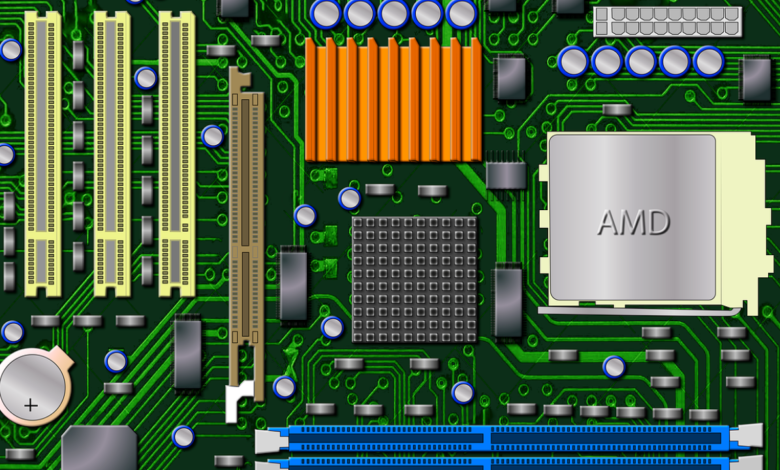AMD Chipset Drivers: The Backbone of Stable PC Performance

Introduction
Have you ever wondered what makes your computer run smoothly when you build a system using AMD components? The unsung hero behind that performance is something most beginners overlook—AMD chipset drivers. These little software packages are crucial in maintaining communication between your processor and the rest of your computer’s hardware. Without the right AMD chipset drivers, even the best CPU can’t perform to its full potential.
What Are AMD Chipset Drivers?
Simply put, AMD chipset drivers are small pieces of software that let your operating system and AMD motherboard chipset work together properly. They’re like interpreters—translating the language of your CPU to your hard drive, RAM, USB ports, and more.
When you install the right AMD chipset drivers, your system becomes more responsive. Think of them as the nervous system connecting all the body parts of your PC.
Why AMD Chipset Drivers Matter
You might be tempted to ignore them if your PC seems to be working fine. But here’s the truth: outdated or missing AMD chipset drivers can cause performance drops, stability issues, power management problems, and even crashes.
These drivers handle essential system processes like:
- Power plans for CPUs
- Data flow between components
- USB, SATA, and PCIe function management
Without proper AMD chipset drivers, all of these may lag, freeze, or function unpredictably.
Choosing Between AMD Chipset Drivers
Choosing between AMD chipset drivers can feel confusing, especially for new PC builders. Should you install from your motherboard manufacturer’s website or directly from AMD?
Here’s a clear answer: while your motherboard maker might offer a basic version, the latest and most optimized AMD chipset drivers are always found directly through AMD’s own site.
This detailed comparison highlights how AMD’s direct drivers often include newer features and bug fixes.
Installation Basics
Installing AMD chipset drivers is a simple but important step after setting up your PC. You just download the executable file, run it, and restart your computer.
However, one thing to remember—always uninstall old or incompatible versions before installing a new one. This ensures no driver conflict slows down your machine.

What’s Inside an AMD Chipset Driver Package?
An AMD chipset drivers bundle isn’t just one driver. It’s a collection of drivers for several onboard functions, such as:
- PCI drivers
- GPIO drivers
- I2C drivers
- Power management drivers
Each of these works silently in the background, allowing your computer to run efficiently. All are tailored to suit AMD architecture.
Updating AMD Chipset Drivers
Keeping your AMD chipset drivers updated means your system stays compatible with the latest Windows features and hardware changes. AMD frequently tweaks these drivers to patch known issues or optimize performance for newer processors.
Always check for new updates every few months. If your system starts acting weird—slow boots, USB issues, or power settings not working—the solution might just be updating your AMD chipset drivers.
Do AMD Chipset Drivers Improve Performance?
The short answer is yes.
The longer answer? AMD chipset drivers improve how efficiently your CPU communicates with your system. Better communication means fewer errors, quicker task handling, and smoother operation overall. It’s not the kind of performance boost you’ll see in flashy benchmark scores, but it’s definitely one you’ll feel in day-to-day use.
Common Mistakes Users Make with AMD Chipset Drivers
- Skipping the install: Some users build their system and run it without ever installing AMD chipset drivers, thinking Windows can handle everything. That’s a recipe for instability.
- Installing wrong versions: Using the wrong AMD chipset drivers can lead to system errors. Always select the one built for your specific chipset model.
- Failing to reboot: A restart is required to apply changes. Don’t skip it.
How to Check If AMD Chipset Drivers Are Installed
To see if your AMD chipset drivers are present, open the Device Manager on Windows and look under system devices. You’ll find entries like “AMD GPIO Controller” or “PCI Bus” using AMD driver signatures. If these are missing or showing yellow alerts, it’s time to reinstall.
AMD Chipset Drivers vs. Generic Windows Drivers
While Windows can install generic chipset drivers, those aren’t optimized for AMD systems. They might allow basic function but won’t offer the full feature set or stability. Always choose AMD chipset drivers designed for your board.
When to Reinstall AMD Chipset Drivers
- You upgrade your CPU
- You experience sudden performance drops
- You reset Windows or do a clean install
- Your motherboard gets firmware updates
In all these cases, AMD chipset drivers should be reinstalled to align with the updated system configuration.
Are Beta AMD Chipset Drivers Safe?
Sometimes, AMD offers beta versions of AMD chipset drivers. These usually bring early support for new CPUs or fix rare bugs. While they can be helpful, they’re not always stable for all users. Stick to the stable versions unless you’re testing a new build or hardware.
What Happens If You Don’t Install AMD Chipset Drivers?
Without AMD chipset drivers, your computer may:
- Run hotter
- Drain more power
- Have USB or PCIe issues
- Boot slowly
- Handle background tasks poorly
They’re not optional—they’re essential.
Best Practices for Installing AMD Chipset Drivers
- Back up your system before installing anything new.
- Use the clean install option if available during setup.
- Install chipset drivers before GPU drivers, especially on fresh builds.
- Reboot twice—first to install, second to stabilize.
Following these steps ensures your AMD chipset drivers work smoothly.
How Often Should You Update AMD Chipset Drivers?
If you’re running a stable system, once every few months is fine. But if you’re tweaking settings, upgrading parts, or using your PC for work that demands high reliability, check for AMD chipset drivers updates monthly.

The Future of AMD Chipset Drivers
As AMD releases new CPUs and motherboards, AMD chipset drivers will evolve too. More integration, smarter power management, and performance boosts are expected in upcoming versions. For those using Ryzen processors, the right AMD chipset drivers could make all the difference in long-term system stability.
Conclusion
If you’re building or upgrading a PC with AMD hardware, never overlook the role of AMD chipset drivers. They may not be as exciting as GPUs or flashy RGB lights, but they’re what keep your system running like it should. Installing and maintaining the correct AMD chipset drivers ensures top performance, efficient power use, and a smooth computing experience.
Whether you’re a gamer, content creator, or just want your machine to last, investing five minutes to install AMD chipset drivers is a smart move.
FAQs
Q1: Do I need to install AMD chipset drivers on a prebuilt PC?
Yes. Even prebuilt systems benefit from up-to-date AMD chipset drivers.
Q2: Will AMD chipset drivers affect gaming performance?
Indirectly, yes. They improve system coordination, which can reduce stutter and improve load times.
Q3: Can I install AMD chipset drivers without internet?
No. You’ll need internet to download the latest package.
Q4: What’s the difference between chipset drivers and GPU drivers?
AMD chipset drivers manage motherboard communication. GPU drivers handle your graphics card.
Q5: Can installing AMD chipset drivers fix blue screen errors?
In some cases, yes. Especially if the blue screen is caused by power management or bus communication errors.
Keep an eye for more news & updates on Evolant Agency!




